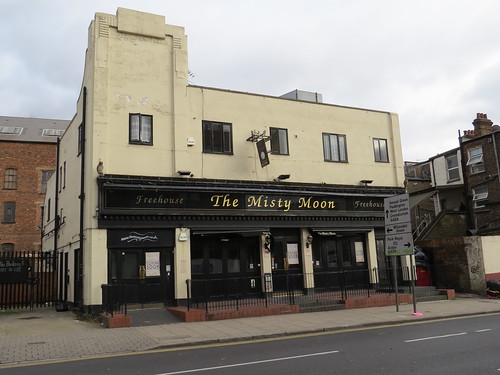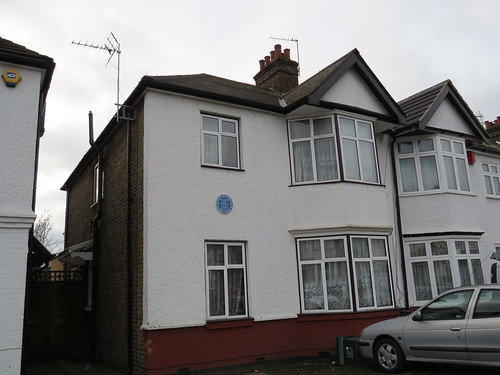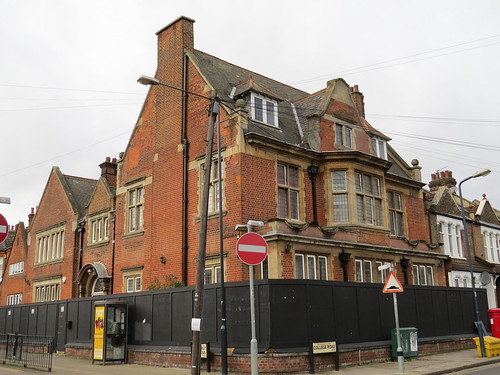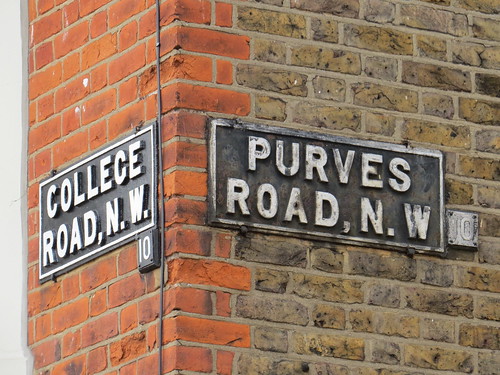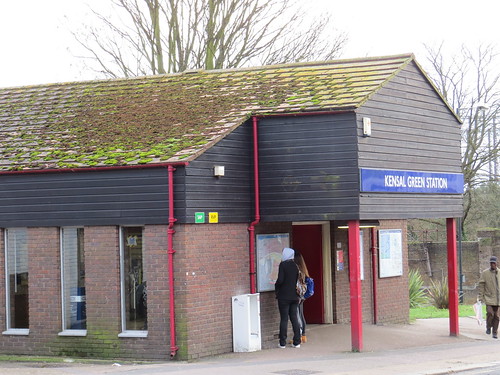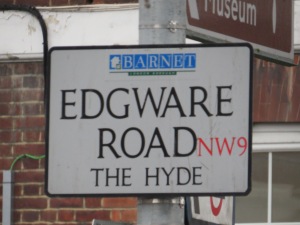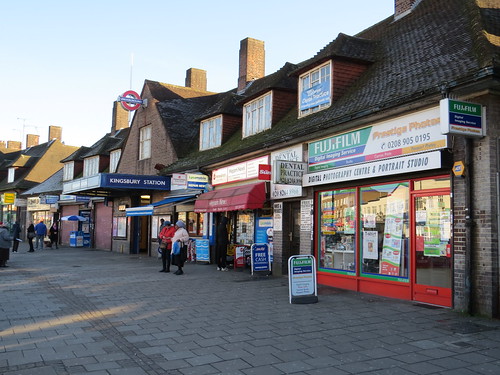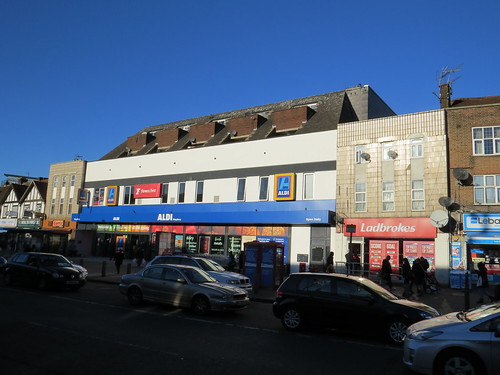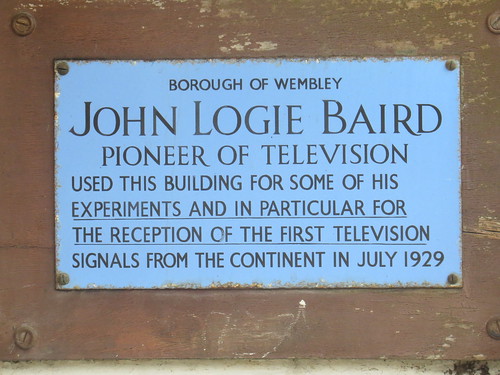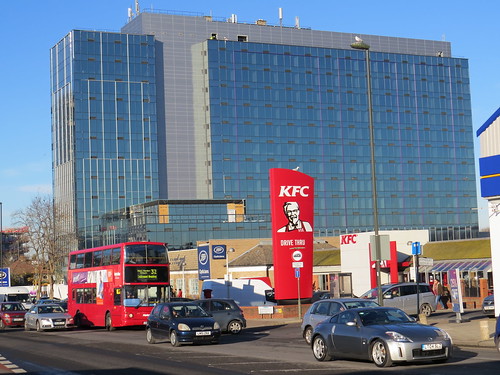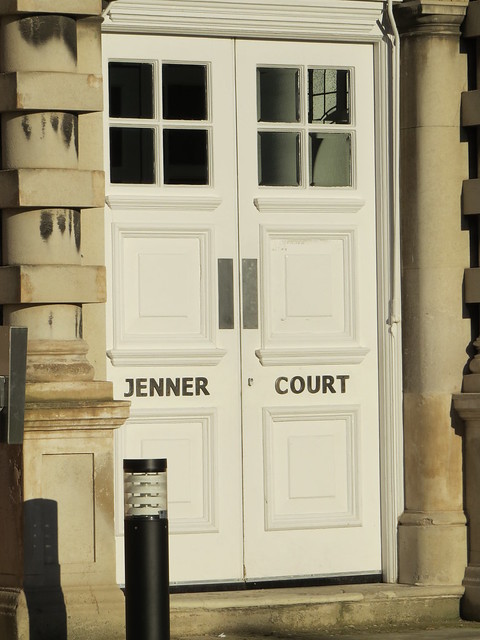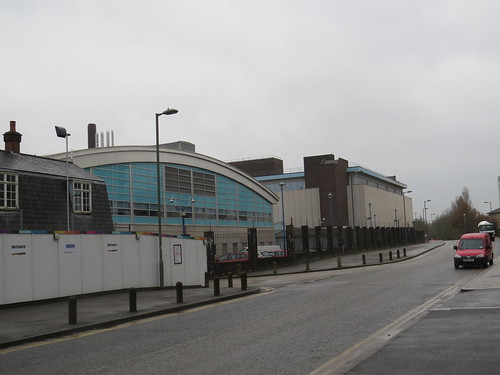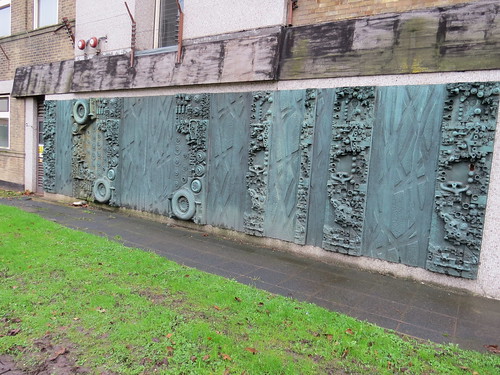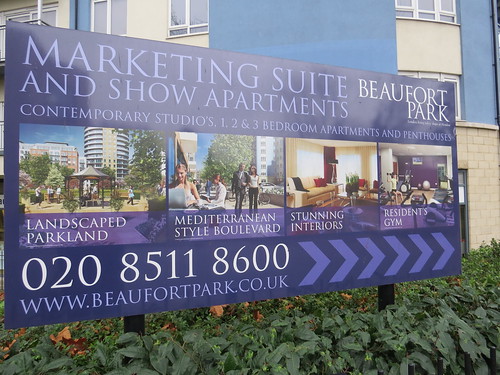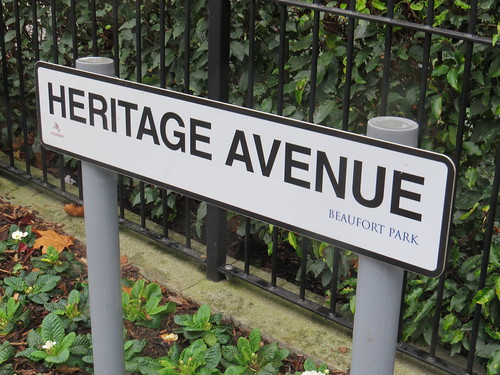NW10 covers Willesden, Harlesden, Kensal Rise and of course Kensal Green, of cemetery fame. The latter does straddles the NW10/W10 border and so we covered that in W10, given the entrance we used was in W10.
We start in Harlesden at the Royal Mail office for NW10 which is at Numbers 32 – 44 Station Road.
Turn right and walk along Station Road. Soon ahead beyond the junction with Tubbs Lane and Old Oak Lane, you will see our first stop just down Station Approach.
This is Willesden Junction station, which is a bit confusing as we started in Harlesden and Station Road does not lead to Harlesden station.
Stop 1: Willesden Junction station
The first station here was built in 1866 on the main London – Birmingham line replacing an earlier Willesden station (which is close to where the current Harlesden station now is).
A high level station was built by the North London Railway in 1869, and a little north of the main line, a new low level station opened in 1916 for the local services between Watford Junction and Euston (the so-called Watford DC line, as it was electrified in the 1920s using a direct current electrical supply) and the Bakerloo line.
The platforms on the main line were taken out as part of the overhead electrification of the West Coast main line in the early 1960s.
All this makes for a rather unsatisfactory station with an eccentric layout: Three low level platforms for Bakerloo line and the Watford DC trains (now the London Overground service between Euston and Watford Junction) and two high level platforms on the old North London Line (now London Overground’s Richmond/Clapham Junction – Stratford service).
And some seemingly random passageways joining the various bits up. This picture is taken from one of the walkways within the station.
I notice that even the signs on the platform kind of hint that maybe this is not actually Willesden.

Retrace your steps along Station Road to the end. Our next stop is at the junction on the right.
Stop 2: All Souls Church
This church is unusual. Quite unenglish.
It is an octagonal brick structure and as architectural historian Pevsner says this is more a plan associated with non-conformist churches. Apparently the plan derives from Rhineland late Romanesque period. The church was extended in 1890 but this bit was demolished in 1978.
And just by the door is a little plaque denoting that Princess Margaret came for the centenary celebrations in 1979 – Pevsner says the church dates from 1875/76, so perhaps it took some time to get consecrated.
Interesting that one of the suffragan (or “assistant”) bishops in the diocese of London is called Willesden. I think this may be a recognition that from 14th to 16th centuries, Willesden was a place of pilgrimage because of two ancient statues of the Virgin Mary at the Church of St Mary. And in the 21st Century a new shrine has been created .http://www.shrineofmary.org/#!shrine/c1xu8
Sadly St Mary’s is not on our route today, but I thought I would mention it as we were by a church.
Cross the main road and stop at the corner of the pedestrianised area.
Stop 3: (site of) Clock Tower
A Jubilee Clock was erected here in 1888 to commemorate Queen Victoria’s Jubilee the previous year. It was made out of cast iron and cost £299. However it is not actually in place (so far as I could see). It should be at the start of this pedestrianised area. Brent Council are redoing the High Street and seemed to have moved the clock – presumably for safe keeping.
Go along the pedestrianised street and out next stop is soon on the right.
Stop 4: The Shawl pub
This Irish pub looks like it could have been a cinema, but the wonderful Cinema Treasures site does not have it listed amongst the 8 building which were used as cinemas in Harlesden.
But a bit of research suggests that this was actually a Methodist Church.
http://commons.wikimedia.org/wiki/File:%27The_Shawl%27,_Harlesden_-_geograph.org.uk_-_1181272.jpg
You can just about see that. Not sure what the founding fathers of this church would have made of it becoming a drinking establishment.
Keep walking along the High Street
Stop 5: The Wig Shop
What is noticeable about this shopping street is the almost complete absence of national chain stores. Even Boots which is on practically everywhere does not have a shop here.
One shop that caught my eye was this one. It is actually three shops together and seems to specialise in hair products for black women. But what is so striking is this extensive range of wigs in the window. There is something rather spooky about this display.
Continue walking along the main shopping street which becomes Craven Park Road. Our next stop is at the junction of St Albans Road on the left.
Stop 6: Odeon Court, Craven Park Road
Here on the corner of St Albans Road was of Oscar Deutsch’s Odeon cinemas – opened in July 1937 and seating just over 1700 people. It had a facade was dominated by a large square tower feature faced in cream faiance tiles and edged in brick.
It closed as a regular cinema in April 1972. It re-opened as an Asian cinema screening Bollywood films under the name Liberty Cinema but soon became a rock concert venue called the Roxy Theatre.
By the 1980s it had become a nightclub called the Tara. After that closed in the mid 1980s, the building was left empty and derelict, finally being demolished in August/September 1989, to be replaced by a development of flats called Odeon Court.
Retrace your steps back alomg the shopping street and turn left into Tavistock Road, where our next stop is on the right
Stop 7: Tavistock Hall
Now NW10 does not appear to have any “proper” blue plaques – ie the ones which English Heritage (or the GLC or LCC) put up.
But NW10 does have some “local” blue plaques and here on the Tavistock Hall is one of them. This commemorates the “UK’s first Roots Reggae Band” who were called the Cimerons. Not a name I recognise but then I am not really that interested in reggae music.
Go to the end of Tavistock Road and turn right into Manor Park Road. Our next stop is just before the end on the left.
Stop 8: former Coliseum cinema (Numbers 25-26 Manor Park Road)
This building was an old cinema – opened in 1912 as the Picture Theatre, it became the Picture Coliseum in 1915.
It closed as a regular cinema in December 1975 and then spent its twilight years showing adult porn films and kung-fu movies. It closed in the mid-1980’s but was reborn as Weatherspoon’s pub in March 1993 called ‘The Coliseum’. It apparently retained many features of its cinematic past and had a huge painted mural of Gary Cooper and Merle Oberon in “The Cowboy and the Lady” where the screen used to be.
However Weatherspoon’s closed the pub (so it is not just chain stores who seems to have given up on Harlesden). It became an independent bar named ‘The Misty Moon’. As of December 2014, the pub is closed but a reopening is promised according to the signs.
At the cross roads, continue straight across. Confusingly this is High Street Harlesden. A little way along on the right is a Paddy Power bookmakers (one big chain that has not abandoned Harlesden – wonder why.)
Stop 9: Number 120 High Street – site of Picardy cinema
It was renamed Picardy Cinema in 1935 and finally closed in October 1957. It then found other uses: an Irish dance hall, a nightclub and finally a snooker club. It was demolished in the spring of 2003 and replaced by this undistinguished building with a Paddy Power Bookmakers at street level and flats above.
Continue walking along the High Street and soon on the left you will see a large office block, containing the local Job Centre Plus.
Stop 10: Harlesden House, Numbers 161-163 High Street
It was taken over by Associated British Cinemas (ABC) in August 1930. It became a full time cinema until September 1938. It then re-opened as a music hall/variety theatre, with films shown on Sundays, when live performances were prohibited.
The Willesden Hippodrome Theatre was destroyed by German bombs in August/September 1940. The remains of the building stood on the High Street for many years. It was finally demolished in 1957. In the 1960s an office block called Harlesden House was built on the site. It was once the Labour Exchange but now houses Job Centre Plus.
As ever, the Arthur Lloyd site was the source of this info and also has a couple of nice exterior shots of the old building: http://www.arthurlloyd.co.uk/WillesdenHippodrome.htm
Continue walking along the High Street and turn left into Furness Road and then right into Wrottesley Road. Our next stop is on the right just before the little roundabout.
Stop 11: Number 8 Wrotessley Road
This modest looking house boasts another one of the local Blue Plaques.
This honours Liz Mitchell who was regarded as the voice of 1970s disco group Boney M.
Boney M. was created by German record producer Frank Farian. Originally based in Germany, the four original members of the group’s official line-up were Jamaican-born singers Liz Mitchell and Marcia Barrett, Maizie Williams from Montserrat and Bobby Farrell from Aruba. The group was formed in 1976 and achieved popularity during the disco era of the late 1970s. Since the 1980s, there have been various line-ups of the band with different personnel, and there have apparently been some disputes about ownership of the name. Liz Mitchell continued to perform in the 21st century, billed as Boney M. featuring Liz Mitchell.
At the little roundabout go clockwise round the roundabout and take the second road on the left. Confusingly although the street you have just crossed is called All Souls Avenue, the church is called something completely different. (presumably the road is called All Souls because the land round here was owned by All Souls College, Oxford.)
This is Bathurst Gardens. It is quite a walk to our final stop which is just at the corner of College Road.
Stop 12: Former Kensal Rise Library
All libraries will end up like this. And all generalisations are false, including this one.
This by the way was Kensal Rise Library. It was opened by Mark Twain in September 1900 and closed a couple of years ago. And in case you have not guessed it, the quote about all generalisations is often attributed to him, although others including Voltaire or Alexandre Dumas have been credited with it.
There was an extensive campaign to save this library. It has had widespread support not just from the local community and the national press, but also various well known people including Alan Bennett, Jacqueline Wilson, Philip Pullman, Zadie Smith.
However it does look like they have not succeeded to keep the library intact. There is a planning application under consideration to convert most of the building to residential use, although a small part would be reserved for community use.
More at: http://www.savekensalriselibrary.org/about/#sthash.8zdO4UVy.dpuf
So that brings us to the end of the NW10 walk. Shame I could not fit in the Capital City Academy which opened in 2003 with building designed by Norman Foster. It is a successor school to Willesden High School which itself had been Willesden Grammar School. Alumni include Thunderbirds puppeteer, Gerry Anderson and actor Shane Ritchie. Old “boys” of the school go by the name “Old Uffs” presumably on account of the fact that the first school was on Uffington Road. They have their very own website:
http://www.olduffs.org/ou/FamousOldUffs.htm
I also could not visit Park Royal – home to many famous names like McVitie’s Biscuits and Heinz and formerly the location of Guinness’ brewery in the UK.
And we never did get to Willesden proper, and the shrine of our Lady of Willesden.
But then again we cannot see everything in a postcode.
For onward travel go down College Road (a right turn from Bathurst Gardens).
Note the old street signs with just the NW – although unlike the ones elsewhere these have the background in black and the name in white. And note also at some point in the past someone has helpfully added a “10” so that you know this is NW 10. Presumably this was cheaper than putting up a new sign!
And after a short walk you will reach Kensal Green station, which is just about where we ended the W10 walk.
Postscript
Kensal Green station originally opened in 1916 but building here is fairly modern dating from 1980.
It looks like it has a green roof – or perhaps not. It maybe just a little overgrown.












